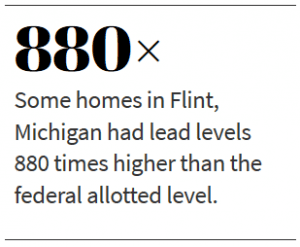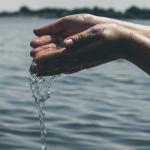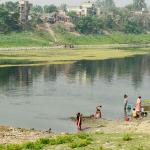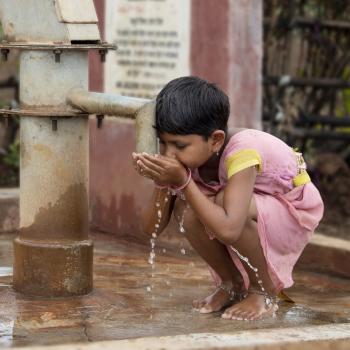Gospel for Asia (GFA), Wills Point, Texas, Special Report 2/4
The Global Clean Water Crisis Exists in America, Too
In her master work titled Dirty, Sacred Rivers: Confronting South Asia’s Water Crisis, Cheryl Colopy, a prize-winning environmental reporter specializing in water systems and clean water restoration, makes a wry observation about the Western form of household waste management:
“But the system I have known and used, quite unconsciously ever since I was potty trained, is nuts. In a world where the supply of clean drinking water is becoming an almost universal worry, why would anyone put clean water into a toilet? For South Asia, flushed toilets and the treatment systems they require have become untenable long before they have become universal. For the Western world, the system as it is currently practiced will surely become untenable before too many more years have passed.”
Orange County, California
Any discussion of clean water inevitably introduces the twin dilemma on the matter of how the world handles human waste. Author Colopy’s point is even now an issue with the state of California, which has concluded that intermittent periods of drought may be the predicted future for its residents. Recycled and purified toilet water (and other grey water from washing machines, dishwashers, showers and sinks, gutters and sidewalks) is the basis for the Orange County Water District pioneering wastewater treatment facility that basically recycles sewage and returns it directly to the drinking supply. Soon, some 100 million gallons per day will meet the water needs of some 850,000 people. When mixed with the groundwater supply, this treatment reaches more than 70 percent of Orange County residents.
Admittedly, the concept of “from toilet to tap,” as the phrase goes, has met with determined resistance, but due to a three-year water shortage crisis and to determined public education, negative reaction seems to be lessening. A public campaign has carefully explained the three steps of the water reclamation project.
“The first is a micro-filtration of the treated waste water to remove solids, oils and bacteria, before the resulting liquid goes through reverse osmosis.” Phase Two means everything is pushed “through a fine plastic membrane that filters out viruses and pharmaceuticals.” Phase Three: “The water is then treated with UV light to remove any remaining organic compounds, before joining the main groundwater supply, which must pass strict quality controls to meet legal standards and distribution to households.” Mike Marcus, the general manager of the Orange County Water District (OCWD) explains that once wastewater goes through this three-step process, “we basically have distilled water.”
Water Reclamation Process
Phase 1
Micro-filtration removes solids, oils and bacteria, all before the water goes through reverse osmosis.
Phase 2
Everything is pushed through a fine plastic membrane that filters our viruses and pharmaceuticals.
Phase 3
The water is treated with UV light to remove any other organic compounds.
The OCWD assures the end-user that the re-treated water exceeds all state and federal drinking standards. As the technology is adapted to other places in the world, water-insecure Singapore, for instance, in addition to new state-side additions launched in Los Angeles, San Francisco and San Diego, the president of the World Water Council, Benedito Braga, reports, “The quality [of effluent water from a sewage treatment plant] is very good, as good or better than the tap water in any city in the developed world.” Thomas Quinn, the head of the Association of California Water Agencies insists this process is a central strategy to drought-proofing modern urban economies.
For those who shudder at the possibility of drinking recycled toilet water, sometimes it is all a matter of what’s in a name. An interview over National Public Radio acknowledged the “yuck” factor many in the public might naturally feel at the thought of recycling water from the toilet to the tap, and that resistance might be helped by a newer nomenclature such as the “the potable reuse project.” The Orange County Water District is being far more upfront in their public campaign by using the hashtag #GetOverIt. NPR Reporter, Nathan Rott, insists that recycled water is and will remain California’s single largest source of new water supplies as the state moves forward into the 21st century.
“The quality [of effluent water from a sewage treatment plant] is very good, as good or better than the tap water in any city in the developed world.”
Then before we turn to the water dilemmas of the two-thirds world and point a finger and tsk-tsk over spoiled rivers and sewage-polluted streams, perhaps we should look hard at the infrastructure inadequacies of our own nation. The news cycles in the States and the headline-oriented emphasis of major networks and cable outreaches leaves little time for in-depth reporting. We have heard, for many years, much discussion regarding the national need for infrastructure renovation—Roads are in disrepair, bridges are crumbling, airports all need upgrading. Rarely—rarely—do we hear that our water infrastructure systems are also in red flag conditions.
Flint, Michigan
The sad result of what is essentially a violation of public trust can be encapsulated by the Flint, Michigan, water saga that happened in April 2014. The drinking source for this city was diverted from the treated Detroit Water and Sewerage Department to the Flint River. This change was influenced by the fact that an estimated $5,000,000 in savings was projected over the next two years. In August and September of 2014, city officials detected levels of coliform bacteria, and a bulletin was issued for Flint citizens to boil their water. In October 2014, General Motors complained about the corrosivity of the water, explaining that car parts were actually corroding. The request was made that GM be able to switch back to the Detroit water source. (It turns out, that corrosive capability of the Flint River water would be determined to also corrode upon lead pipes, leaching lead levels into the water supply of individual homes. An early investigation by one “whistle-blowing” worker determined that, despite standard practice, officials failed to apply corrosion inhibitors to the Flint River water.) In January 2015, in a public meeting, citizens complained about bad water—murky tap water; there was a bad smell and taste as well as the questionable appearance. These complaints appeared to have gone on over an 18-month period before a local physician, taking it upon himself, found highly elevated blood lead levels in the children of Flint.
Eventually, with city officials dodging complaints, issuing false reports to state regulators indicating that “tests at Flint’s water treatment plant had detected no lead and testing in homes had registered lead at acceptable levels,” and with Michigan’s Department of Environmental Quality eventually being pegged as the major player in denying the problem and refusing to take action, major players, too numerous to mention, finally stepped in. Scientists and physicians and medical schools and environmental organizations, both private and governmental, determined that the proportion of infants and children with elevated levels of lead in their blood had nearly doubled since the switch to the Flint River.
In September 2015, Dr. Marc Edwards, notified by a Flint resident whose alarms had been ignored by city officials, began testing Flint water with a team from Virginia Tech to perform lead level testing. Working with a grant from the National Science Foundation, he and his student team reported that at least a quarter of Flint households had levels of lead above the federal allotted level of 15 parts per billion (ppb) and that in some homes, lead levels were at 13,200 ppb. Edwards summarized the Flint Water Crisis by stating: “It was the injustice of it all and that the very agencies that are paid to protect these residents from lead in water, knew or should have known after June at the very latest of this year, that federal law was not being followed in Flint, and that these children and residents were not being protected. And the extent to which they went to cover this up exposes a new level of arrogance and uncaring that I have never encountered.”
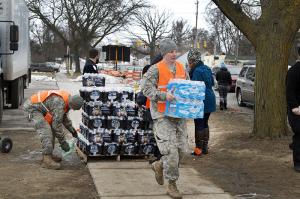
This all, of course, has resulted in countless hearings, investigations, and continued studies on the local, statewide and national levels. Emergency centers for distributing water and home filters, then replacement cartridges, have been established. Testing water and lead levels in the blood of children continue. The water supply was diverted back to the Detroit Water and Sewerage Department. Numerous Class action suits have been filed against Michigan Governor Rick Snyder and 13 other state officials, including former Flint mayor Dayne Walling. The complaints allege that the officials acted recklessly and negligently, leading to serious injuries from lead poisoning.
Needless to say, major funding has been found and pledged for comprehensive water infrastructure improvement, all to be carried out over the next few years. But what is immeasurable is the damage done to the brains of small children, most of which cannot now be determined but which bodes ill for the future of these kids. Senators Debbie Stabenow and Gary Peters along with Representative Dan Kildee called upon the state of Michigan to “make a sustained financial commitment by establishing a Future Fund to meet the cognitive, behavioral and health challenges of children affected by lead poisoning.” All fear that those challenges will be real and life-lasting.
This material originally appeared in Gospel for Asia’s special report “The Global Clean Water Crisis: Finding Solutions to Humanity’s Need for Pure, Safe Water.”
=====
Click here, to read more blogs on Patheos from Gospel for Asia.
Go here to know more about Gospel for Asia: Youtube | Twitter | GFA Reports | My GFA
For more information about this, click here.


